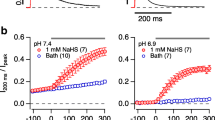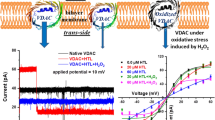Abstract
Reactive oxygen species (ROS) readily oxidize the sulfur-containing amino acids cysteine and methionine (Met). The impact of Met oxidation on the fast inactivation of the skeletal muscle sodium channel NaV1.4 expressed in mammalian cells was studied by applying the Met-preferring oxidant chloramine-T or by irradiating the ROS-producing dye Lucifer Yellow in the patch pipettes. Both interventions dramatically slowed down inactivation of the sodium channels. Replacement of Met in the Ile–Phe–Met inactivation motif with Leu (M1305L) strongly attenuated the oxidizing effect on inactivation but did not eliminate it completely. Mutagenesis of Met1470 in the putative receptor of the inactivation lid also markedly diminished the oxidation sensitivity of the channel, while that of other conserved Met residues in intracellular linkers connecting the membrane-spanning segments (442, 1139, 1154, 1316, 1469) were of minor importance. The results of mutagenesis, assays of other NaV channel isoforms (NaV1.2, NaV1.5, NaV1.7), and the kinetics of the oxidation-induced removal of inactivation collectively indicate that multiple Met residues need to be oxidized to completely impair inactivation. This arrangement using multiple Met residues confers a finely graded oxidative modulation of NaV channels and allows organisms to adapt to a variety of oxidative stress conditions, such as ischemic reperfusion.






Similar content being viewed by others
References
Vogt W (1995) Oxidation of methionyl residues in proteins: tools, targets, and reversal. Free Radic Biol Med 18:93–105
Weissbach H, Etienne F, Hoshi T, Heinemann SH, Lowther LW, Matthews B, John GS, Nathan C, Brot N (2002) Peptide methionine sulfoxide reductase: structure, mechanism of action and biological function. Arch Biochem Biophys 397:172–178
Hoshi T, Heinemann SH (2001) Regulation of cell function by methionine oxidation and reduction. J Physiol 531:1–11
Levine RL, Mosoni L, Berlett BS, Stadtman ER (1996) Methionine residues as endogenous antioxidants in proteins. Proc Natl Acad Sci U S A 93:15036–15040
Bigelow DJ, Squier TC (2005) Redox modulation of cellular signaling and metabolism through reversible oxidation of methionine sensors in calcium regulatory proteins. Biochim Biophys Acta 1703:121–134
Ciorba MA, Heinemann SH, Weissbach H, Brot N, Hoshi T (1997) Regulation of potassium channel function by methionine oxidation and reduction. Proc Natl Acad Sci U S A 94:9932–9937
Kuschel L, Hansel A, Schönherr R, Weissbach H, Brot N, Hoshi T, Heinemann SH (1999) Molecular cloning and functional characterization of a human peptide methionine reductase (hMsrA). FEBS Lett 456:17–21
Jung S, Hansel A, Kasperczyk H, Hoshi T, Heinemann SH (2002) Activity, tissue distribution and site-directed mutagenesis of a human peptide methionine sulfoxide reductase of type B: hCBS1. FEBS Lett 527:91–94
Desaphy J-F, De Luca A, Imbrici P, Camerino DC (1998) Modification by ageing of the tetrodotoxin-sensitive sodium channels in rat skeletal muscle fibres. Biochim Biophys Acta 1373:37–46
Lin CS-Y, Grosskreutz J, Burke D (2002) Sodium channel function and the excitability of human cutaneous afferents during ischaemia. J Physiol 538:435–446
Ma JH, Luo AT, Zhang PH (2005) Effect of hydrogen peroxide on persistent sodium current in guinea-pig ventricular myocytes. Acta Pharmacol Sin 26:828–834
Song Y, Shryock JC, Wagner S, Maier LS, Belardinelli L (2006) Blocking late sodium current reduces hydrogen peroxide-induced arrhythmogenic activity and contractile dysfunction. J Pharm Exp Therap 318:214–222
Eaholtz G, Scheuer T, Catterall WA (1994) Restoration of inactivation and block of open sodium channels by an inactivation gate peptide. Neuron 12:1041–1048
Tang L, Kallen RG, Horn R (1996) Role of an S4–S5 linker in sodium channel inactivation probed by mutagenesis and a peptide blocker. J Gen Physiol 108:89–104
Black SD, Mould DR (1991) Development of hydrophobicity parameters to analyze proteins which bear post- or cotranslational modifications. Anal Biochem 193:72–82
Wang GK (1984) Irreversible modification of sodium channel inactivation in toad myelinated nerve fibres by the oxidant chloramine-T. J Physiol 346:127–141
Wang GK, Brodwick MS, Eaton DC (1985) Removal of sodium channel inactivation in squid axon by the oxidant chloramine-T. J Gen Physiol 86:289–302
Huang JM, Tanguy J, Yeh JZ (1987) Removal of sodium channel inactivation and block of sodium channels by chloramine-T in crayfish and squid giant axons. Biophys J 52:155–163
Quiñonez M, DiFranco M, González F (1999) Involvement of methionine residues in the fast inactivation mechanism of the sodium current from toad skeletal muscle fibers. J Membr Biol 169:83–90
Wang GK, Wang SY (2002) Modifications of human cardiac sodium channel gating by UVA light. J Membr Biol 189:153–165
Trimmer JS, Cooperman SS, Tomiko SA, Zhou JY, Crean SM, Boyle MB, Kallen RG, Sheng ZH, Barchi RL, Sigworth FJ, Goodman RH, Agnew WS, Mandel G (1989) Primary structure and functional expression of a mammalian skeletal muscle sodium channel. Neuron 3:33–49
Noda M, Ikeda T, Suzuki H, Takeshima H, Takahashi T, Kuno M, Numa S (1986) Expression of functional sodium channels from cloned cDNA. Nature 322:826–828
Klugbauer N, Lacinova L, Flockerzi V, Hofmann F (1995) Structure and functional expression of a new member of the tetrodotoxin-sensitive voltage-activated sodium channel family from human neuroendokrine cells. EMBO J 14:1084–1090
Gellens ME, George Jr AL, Chen LQ, Chahine M, Horn R, Barchi RL, Kallen RG (1992) Primary structure and functional expression of the human cardiac tetrodotoxin-insensitive voltage-dependent sodium channel. Proc Natl Acad Sci U S A 89:554–558
Chen H, Gordon D, Heinemann SH (2000) Modulation of cloned skeletal muscle sodium channels by the scorpion toxins Lqh II, Lqh III, and LqhαIT. Pflügers Arch 439:423–432
Higure Y, Katayama Y, Takeuchi K, Ohtubo Y, Yoshii K (2003) Lucifer Yellow slows voltage-gated Na+ current inactivation in a light-dependent manner in mice. J Physiol 550:159–167
Tang XD, Daggett H, Hanner M, Garcia ML, McManus O, Brot N, Weissbach H, Heinemann SH, Hoshi T (2001) Oxidative regulation of large conductance calcium-activated potassium channels. J Gen Physiol 117:253–273
McPhee JC, Ragsdale DS, Scheuer T, Catterall WA (1998) A critical role for the S4–S5 intracellular loop in domain IV of the sodium channel α-subunit in fast inactivation. J Biol Chem 273:1121–1129
Stadtman ER (2006) Protein oxidation and aging. Free Radic Res 40:1250–1258
Chakravarti B, Chakravarti DN (2007) Oxidative modification of proteins: age-related changes. Gerontology 53:128–139
Eaholtz G, Colvin A, Leonard D, Taylor C, Catterall WA (1999) Block of brain sodium channels by peptide mimetics of the isoleucine, phenylalanine, and methionine (IFM) motif from the inactivation gate. J Gen Physiol 113:279–293
Schlief T, Schönherr R, Heinemann SH (1996) Modification of C-type inactivating shaker potassium channels by chloramine-T. Pflügers Arch 431:483–493
Su Z, Limberis J, Martin RL, Xu R, Kolbe K, Heinemann SH, Hoshi T, Cox BF, Gintant B (2007) Functional consequences of methionine oxidation of hERG potassium channels. Biochem Pharm 74:702–707
Ciali Santarelli L, Wassef R, Heinemann SH, Hoshi T (2006) Three methionine residues located within the RCK domains confer oxidative sensitivity to large-conductance calcium-activated K+ channels. J Physiol 571:329–348
Ashcroft FM (2000) Ion Channels and Disease. Academic, San Diego
Birnbaum Y, Leor J, Kloner RA (1997) Pathobiology and clinical impact of reperfusion injury. J Thromb Thrombolysis 4:185–195
Gazmuri RJ, Ayoub IM, Kolarova J (2003) Myocardial protection during resuscitation from cardiac arrest. Curr Opin Crit Care 9:199–204
Kevin LG, Novalija E, Stowe DF (2005) Reactive oxygen species as mediators of cardiac injury and protection: the relevance to anesthesia practice. Anesth Analg 101:1275–1287
Hale SL, Kloner RA (2006) Ranolazine, an inhibitor of the late sodium channel current, reduces postischemic myocardial dysfunction in the rabbit. J Cardiovasc Pharmacol Ther 11:249–255
Acknowledgments
This work was supported by Deutsche Forschungsgemeinschaft (HE2993/7-1, S.H.H.), IZKF/TMWFK (B307-04004, S.H.H.), and National Institutes of Health (T.H.). We thank J. Trimmer for providing cDNA coding for rNaV1.4, N. Klugbauer for hNaV1.7, S. Noda for rNaV1.2, A. George for hNaV1.5, and S. Arend and A. Rossner for technical assistance.
Author information
Authors and Affiliations
Corresponding author
Rights and permissions
About this article
Cite this article
Kassmann, M., Hansel, A., Leipold, E. et al. Oxidation of multiple methionine residues impairs rapid sodium channel inactivation. Pflugers Arch - Eur J Physiol 456, 1085–1095 (2008). https://doi.org/10.1007/s00424-008-0477-6
Received:
Accepted:
Published:
Issue Date:
DOI: https://doi.org/10.1007/s00424-008-0477-6




